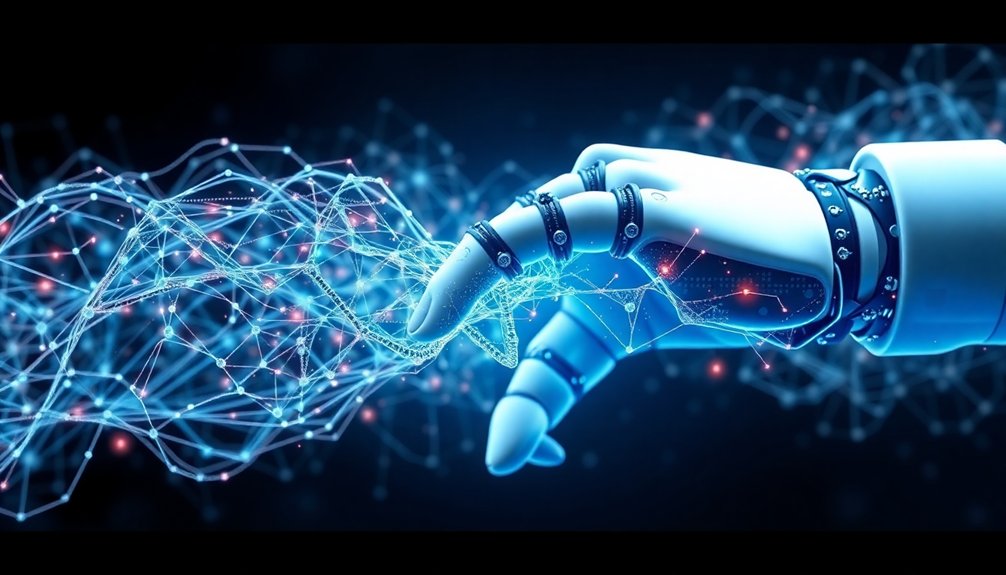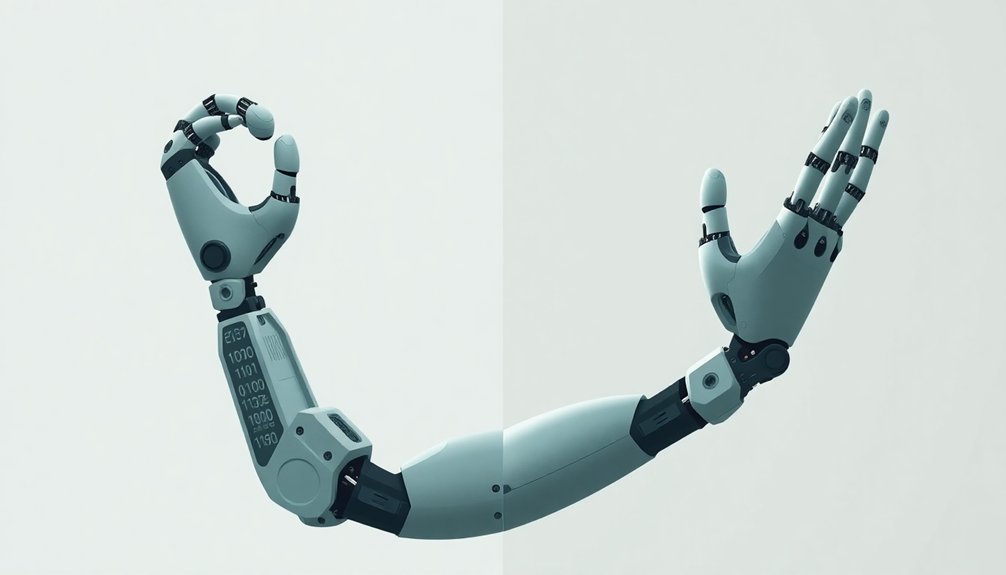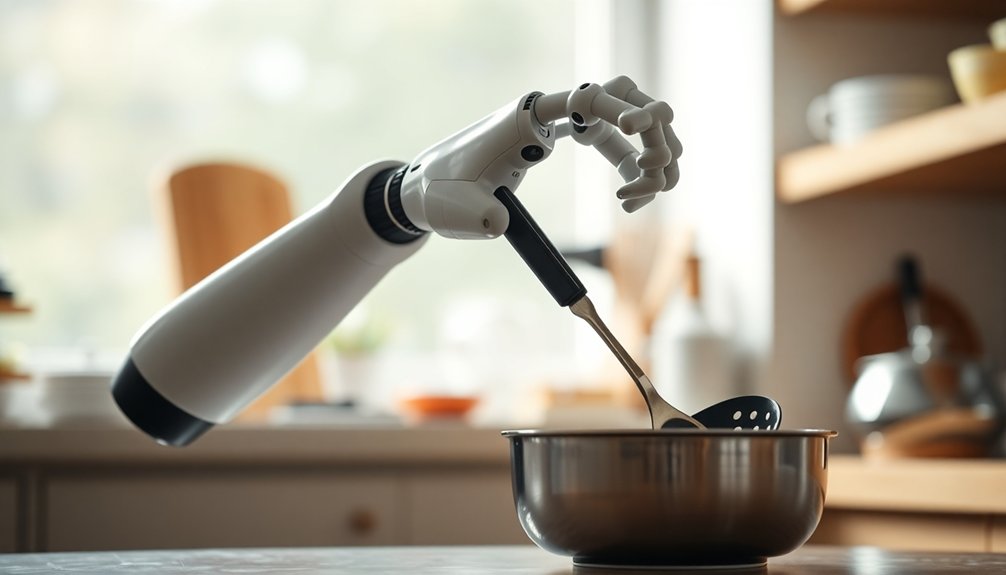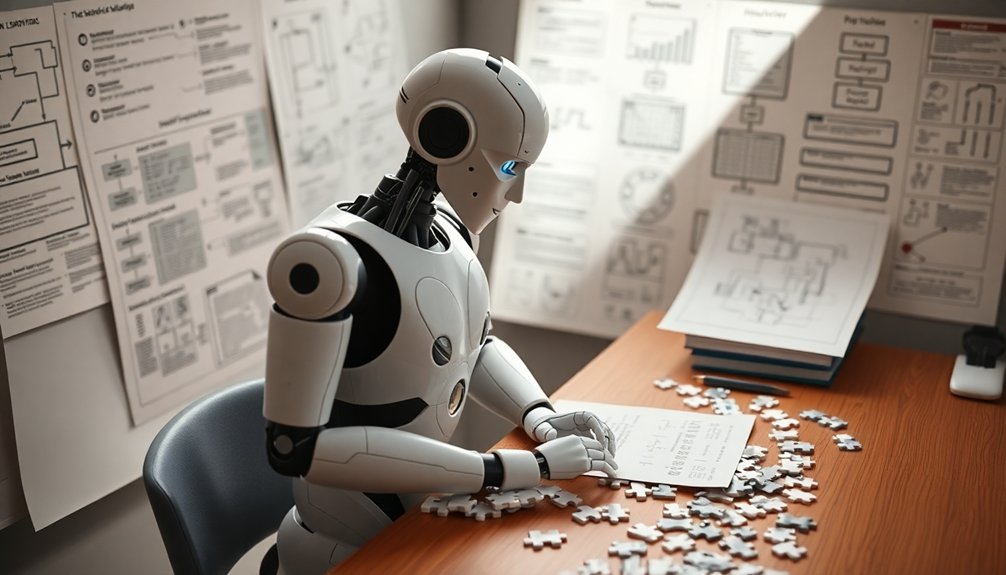AI is transforming robots from dumb machines into smart, intuitive companions. You’re watching computers learn common sense through advanced neural networks that mimic human thinking. Robots now experiment, adapt, and understand context in ways that seem almost magical. They’re not just following algorithms anymore—they’re learning from experience, interpreting subtle cues, and making decisions that feel eerily human. Curious about how deep this rabbit hole goes?
The Evolution of Robotic Intelligence

While robots once followed rigid, pre-programmed scripts like obedient but brainless machines, they’re now evolving into something far more fascinating.
Common sense isn’t just for humans anymore. Today’s robotic intelligence is shifting from strict rule-based programming to systems that can actually think and adapt.
Intelligence is no longer human-exclusive: robots are transcending rigid scripts and learning to think dynamically.
Imagine a robot that doesn’t just blindly execute commands, but understands context and interprets human gestures. These cognitive engines are processing real-time knowledge, making split-second decisions in complex environments.
It’s like giving machines a brain that doesn’t just compute, but comprehends. Researchers are breaking down barriers, creating platforms that let developers inject genuine reasoning into robot software.
The result? Robots that aren’t just tools, but intelligent collaborators who can navigate our unpredictable world with something remarkably close to human intuition. Through neuromorphic computing, these systems are revolutionizing machine thinking by mimicking the brain’s adaptive neural networks.
Decoding Common Sense for Machines
You’ve probably wondered why robots can crunch massive calculations but still can’t figure out how to grab a coffee mug without knocking over everything nearby. Reinforcement learning techniques are rapidly transforming robots from rigid machines into adaptive learners that can understand and respond to complex environments like curious explorers.
The quest for machine “instincts” is all about teaching AI to reason like humans do—not just by following rigid algorithms, but by understanding context, anticipating outcomes, and making intuitive leaps that go beyond pure data processing.
Imagine robots that can adapt to unexpected situations, learn from subtle environmental cues, and bridge the cognitive gaps that currently make them feel more like fancy calculators than intelligent companions.
Machines Learning Instincts
Because humans learn through experience, why shouldn’t robots? Imagine AI gaining instincts like people without traditional programming. Researchers are crafting digital environments where machines can experiment, stumble, and learn just like curious toddlers. Isaac Gym’s virtual simulation enables robots to practice complex movements through reinforcement learning, mimicking human developmental processes.
The Allen Institute’s THOR platform lets AI play and interact, turning clumsy trial-and-error into sophisticated understanding. Think of it as robot bootcamp for common sense.
These developmental approaches mimic how humans naturally absorb knowledge—through messy, unpredictable interactions. Self-driving cars need more than rigid rules; they require adaptive reasoning that anticipates weird roadway scenarios.
Current AI systems are basically walking rulebooks, but emerging research suggests we can teach machines to think more flexibly, more intuitively.
The future? Robots that don’t just compute, but genuinely comprehend.
Reasoning Beyond Algorithms
If traditional AI is a robot playing chess with rigid, pre-programmed moves, common sense reasoning is like teaching that same robot to improvise a dance.
You’re witnessing a radical shift in machine intelligence that goes beyond algorithmic limitations. While current AI systems crunch data like calculators, researchers are pushing boundaries by mimicking how children learn—asking “why” and exploring environments with curiosity.
Imagine robots that don’t just process instructions, but understand context and nuance. They’ll interpret human gestures, adapt to unexpected scenarios, and make intuitive leaps.
The secret? Developing symbolic knowledge graphs and immersive learning environments that let machines experience the world, not just analyze it. Common sense isn’t about memorizing rules; it’s about understanding the messy, unpredictable nature of human interaction.
Humanoid robots can now learn through deep reinforcement learning, transforming their ability to navigate complex environments with unprecedented adaptability.
Bridging Cognitive Gaps
When machines start acting like curious toddlers instead of robotic calculators, we’ll know we’re cracking the code of artificial common sense. By mimicking how human babies learn, AI researchers are teaching robots to understand context beyond rigid algorithms. Digital twin simulations are providing advanced training grounds that enable robots to explore complex scenarios safely before real-world deployment.
Think of it like giving machines a playbook for real-world improvisation. They’re experimenting with digital environments like THOR, where AI can interact physically and predict outcomes, fundamentally learning through trial and error.
The goal? Help robots navigate unpredictable scenarios without freezing up or causing unintended harm. Current AI might be brilliant at calculations, but it still struggles with the nuanced understanding a child instinctively grasps.
It’s not just about programming intelligence—it’s about cultivating genuine curiosity and adaptive reasoning that makes machines feel almost… human.
Learning Beyond Algorithms: AI’s New Frontier
Since the dawn of artificial intelligence, researchers have been chasing a holy grail: teaching machines to think like humans.
You’re witnessing a radical shift where robots aren’t just programmed—they’re learning. Imagine AI systems studying child development, mimicking how kids explore and understand the world through messy, unpredictable interactions.
AI’s quantum leap: machines now learning like curious children, embracing unpredictability and discovery.
THOR’s digital playground and PIGLET’s physical interaction experiments are cracking the code of machine common sense.
By collaborating with developmental psychologists, researchers are teaching robots to interpret context, predict outcomes, and navigate complex social scenarios. Robotic sensor perception allows machines to capture environmental details with unprecedented precision, bridging the gap between programmed responses and intuitive understanding.
The future? Robots that don’t just compute, but comprehend. Mind-bending, right?
Bridging the Gap Between Programming and Understanding

Imagine an AI that doesn’t just see a cup, but understands it can be used for drinking, holding flowers, or as an impromptu drumstick — that’s the quantum leap in machine intelligence we’re talking about. Robots are now developing adaptive vision systems that allow them to learn and interpret their environment dynamically, transforming raw visual data into meaningful insights through advanced machine learning algorithms.
Learning Beyond Algorithms
Neural networks are now evolving beyond simple pattern recognition, learning through immersive experiences that mimic human development. Imagine robots picking up social cues like curious toddlers, interpreting gestures and predicting outcomes in real-world scenarios. Ethical machine learning is enabling robots to move beyond binary decision-making by understanding complex moral nuances inherent in human interactions.
They’re no longer just following pre-programmed rules but actually understanding context. By grounding language in physical interactions, researchers are teaching machines to think more like humans—adaptable, intuitive, and responsive.
The future isn’t about creating perfect robots, but developing intelligent systems that can learn, adjust, and surprise us with their capacity for nuanced reasoning.
Sensing Real-World Nuance
Imagine a world where robots don’t just follow commands, but understand context and intention. That’s where common sense comes into play.
AI is teaching robots to pick up on subtle human cues, transforming them from rigid programs to adaptive companions. They’re learning to interpret gestures, read emotional undertones, and respond with nuanced understanding. Neuromorphic computing enables robots to develop deeper emotional intelligence and more sophisticated interaction capabilities.
It’s not about complex algorithms anymore; it’s about bridging the gap between programmed responses and real-world complexity.
These cognitive robots will revolutionize eldercare, workplace interactions, and personal assistance by sensing what humans really mean, not just what they literally say.
Real-World Adaptability in Robotic Systems
Because robots aren’t just fancy remote-controlled toys anymore, real-world adaptability has become the holy grail of robotic engineering. Common sense isn’t just a human thing now – it’s transforming how machines understand our messy, unpredictable world. Companion robots’ emotional limitations highlight the complexity of creating truly empathetic artificial intelligence.
Consider these robotic superpowers:
- Interpreting human gestures beyond programmed responses
- Predicting behavior in complex social environments
- Learning from unexpected interactions
- Adjusting in real-time to dynamic scenarios
Imagine a robot in eldercare that doesn’t just follow instructions, but understands the subtle emotional cues of its human companion. That’s where we’re heading.
By integrating cognitive engines that mimic human reasoning, robots are shifting from rigid automatons to adaptive partners. They’re learning to read between the lines, anticipate needs, and navigate social nuances that once seemed impossibly complex.
The future isn’t about replacing humans – it’s about understanding them.
Contextual Decision-Making: The AI Breakthrough

If you’ve ever watched a robot bumble through a simple task and thought, “Seriously? This is supposed to be cutting-edge tech?” — contextual decision-making is about to blow your mind.
This AI breakthrough means robots aren’t just following rigid instructions anymore. They’re learning to read between the lines, understand human intent, and adapt on the fly.
Imagine a robot that doesn’t just see a room, but understands the nuanced dynamics of human behavior. It predicts your next move, navigates complex environments, and makes split-second decisions that actually make sense.
We’re talking about machines that learn from experience, optimize tasks, and communicate more naturally than ever before.
This isn’t sci-fi. It’s happening now.
Mimicking Human Intuition Through Machine Learning
Let’s face it: teaching robots to think like humans sounds about as likely as teaching your cat to do taxes. But machine learning is changing the game, and here’s how:
- Robots now learn by watching and mimicking human behaviors
- AI systems are developing something close to intuition
- Algorithms can now interpret complex contextual cues
- Cognitive robotics is bridging the human-machine gap
Imagine a robot that doesn’t just follow programmed instructions, but actually understands the “why” behind actions. By training these systems on massive datasets, researchers are fundamentally giving machines a crash course in common sense.
Machines learning the art of intuition: decoding actions beyond basic programming through massive data training.
They’re teaching robots to explore, adapt, and make decisions that feel almost… human. It’s like raising a digital child who learns through interaction instead of rigid rulebooks.
The result? Smarter, more flexible machines that can navigate unpredictable scenarios with uncanny precision.
Challenges in Teaching Robots to Think

While teaching robots to think might sound like science fiction, the reality is far more complex than simply uploading a digital brain. Your average robot needs help understanding the nuanced world of human behavior.
Imagine trying to explain sarcasm to a machine that only processes literal instructions—it’s like teaching a toddler quantum physics. The core challenge isn’t just programming rules, but helping robots grasp context and unpredictability.
They’re basically overgrown calculators struggling to decode subtle human gestures and intentions. Cognitive scientists and robotics experts are working to crack this code, blending psychology and advanced machine learning.
But here’s the kicker: creating robots with genuine common sense isn’t just about algorithms—it’s about teaching machines to think like humans, with all our beautiful, messy complexity.
The Future of Human-Robot Interaction
The road from programming robotic calculators to creating machines that understand human nuance leads us directly into the wild frontier of human-robot interaction.
As humans learn to design smarter machines, robots are evolving from clunky tools to intelligent companions:
- Cognitive engines now process real-time knowledge
- Robots interpret gestures and situational context
- Predictable interactions build human-robot trust
- Dynamic environment navigation becomes seamless
Imagine eldercare robots that understand your mood, retail assistants anticipating your needs, and healthcare companions adapting instantly to your actions.
These aren’t sci-fi fantasies—they’re emerging technologies transforming how we collaborate with machines.
The future isn’t about robots replacing humans, but working alongside us with unprecedented intuition.
Can you picture a world where machines truly get us, where common sense isn’t just human territory anymore?
People Also Ask About Robots
How Does AI Learn Common Sense?
You’ll learn common sense by exploring interactive environments, asking probing questions, and mimicking human learning patterns. AI systems develop intuitive understanding through symbolic knowledge graphs and problem-solving techniques that mirror how children naturally acquire knowledge.
How Is AI Changing Robotics?
You thought robots were just cold, programmed machines? AI’s revolutionizing robotics by enabling adaptive learning, context understanding, and intuitive decision-making, transforming them from rigid automatons into intelligent, responsive companions that anticipate and interact with human environments seamlessly.
Why Does AI Have No Common Sense?
You’ll find AI lacks common sense because it can’t truly experience or intuitively understand complex real-world scenarios like humans do, relying instead on rigid algorithms and pattern recognition without deeper contextual comprehension.
How the AI Is Changing the World?
By 2030, AI could boost global GDP by $15.7 trillion. You’ll witness revolutionary changes as AI transforms industries, automates complex tasks, enhances decision-making, and creates unprecedented opportunities across healthcare, finance, transportation, and personal technology.
Why This Matters in Robotics
You’re standing at the edge of a robotic revolution where AI isn’t just coding—it’s teaching machines to think like humans. By 2030, experts predict 85% of robots will have some form of contextual understanding, transforming how they interact with our world. Imagine machines that don’t just follow instructions, but genuinely comprehend situations, adapt, and make nuanced decisions. The future isn’t about replacing humans—it’s about creating intelligent partners who understand context, complexity, and compassion.
